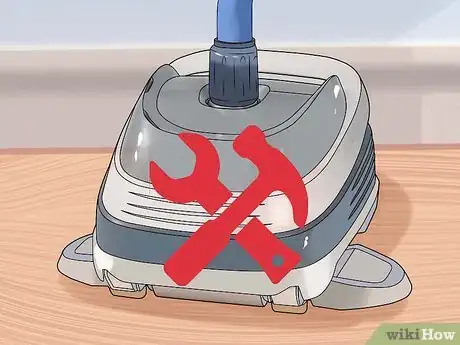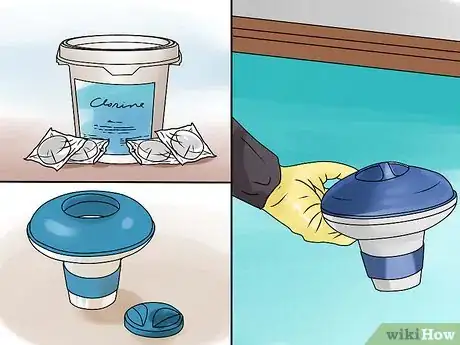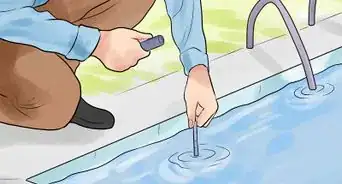This article was co-authored by Rob Litman. Rob Litman is a Landscaper, General Contractor, and the CEO of Vitoli Inc., a landscaping, hardscaping, ecoscaping, and swimming pool design company in Los Angeles, California. With over 20 years of experience in construction, Rob specializes in energy-efficient and drought-tolerant landscaping. He holds General Building Contractor (Class B) and Registered Pool/Spa Contractor Licenses. In 2007, Rob won House of the Year in Gardena, California.
This article has been viewed 66,351 times.
Pool care can seem like an overwhelming task that you may outsource to the pros. Don’t become intimidated by all the chemicals and test kits. Once you have all the supplies and follow a cleaning schedule, you’ll find the task is manageable. Take pride in your pool and you’ll feel better having cleaned the pool next time you’re floating with a daiquiri.
Steps
Getting the Equipment
-
1Determine how to chlorinate. Chlorine is necessary for any pool owner, but there are a few options on how to administer the chlorine. You can administer chlorine manually or you can invest in a salt water system that creates its own chlorine. Salt water pools are more expensive, but require less maintenance and use safer chlorine levels than regular pools.[1]
- If you go with a salt water system, you can avoid doing much of what is discussed below.
- If you already have a chlorinated pool, don't bother switching to a salt system. These systems are much more expensive than chlorine.[2]
-
2Gather test equipment. A major aspect of proper pool care is how regularly you test the alkalinity, pH, calcium hardness, and chlorine. At all major pool supply stores you can buy basic and advanced testing equipment. The equipment consists of a container and a series of chemicals that respond to certain chemicals in the pool.
- The tests require you to add two-five drops of various chemicals and compare the color of your pool water to a chart. From this information, you’ll know if your pool is safe to use.
- There are also test strips that use a similar color comparison test.
Advertisement -
3Buy a cleaner. All pools use a motorized pool cleaner and they come in three different types. Use the following information to decide on which is best for you and your pool:
- Suction side pool cleaners are low in cost, require fewer moving parts, and are easy to maintain. The only problem is they increase pressure on your filter and require a pool pump.
- Pressure side pool cleaners are similar to the suction cleaner expect they relieve pressure on the pool filter. The only problem with these is that they sometimes require an extra booster pump.
- Robotic cleaners offer superior cleaning, energy efficiency, and eliminates the wear on your pool. The only drawback to the robotic cleaners is that they are much more expensive.[3]
-
4Gather a skimmer and brush. The skimmer and brush system accounts for all the blemishes not picked up by the pool cleaner. You can usually buy a kit at your pool supply store that includes a staff with an interchangeable skimmer or brush.
-
5Buy chemicals. For your first time purchasing pool chemicals, go to a pool supply store and talk to a specialist. These are serious chemicals that could cause problems for your pool goers' health. Find an all inclusive starter kit that includes chlorine, calcium, alkalinity stabilizer, and algaecide.
- You can also substitute chlorine with bromine. Bromine tablets are reliable in killing bacteria and keeping your pool clear.
Maintaining Your Pool
-
1Install your pool cleaner. You should plan on connecting your pool cleaner about once a week. Doing this reduces the amount of chemicals you’ll need to add to the pool. If your cleaner attaches to a pump, you’ll need to attach the hose attached to the cleaner into the pump.
- The pump should be in your pool. It will be the spot in your pool that pumps out water.
- After each use, you should check and clean out the filter of the cleaner.
-
2Clean the pool filter. There are three different types of filters: cartridge, sand, and diatomaceous earth. Each type of filter will require different cleaning techniques. For each filter you’ll need to make sure the system is off and bleed all the air from the filter.
- For cartridge filters you’ll need to remove the filter out its base and take time to spray down the cartridge with a hose. Use a high pressured hose with a point for best results.
- To clean a sand filter you’ll need to make sure the sand filter is detached from the plumbing of the pool system. It’s best to do this at the start of the season. Then take the time to clean out the top part of the filter with a high pressured hose.
- Diatomaceous earth filters should be cleaned once a month. The first step is to backwash the filter, then spend time spraying the grids with a high pressured hose.[4]
-
3Balance the pool. About once a week you should use the chemical tester kit to ensure you have the proper chemical levels. Be sure you check the three main tests: pH, alkalinity, and calcium hardness. Use the color coded guide on your test kit to determine if you need more or less chemicals.
- Doing this regularly increases the longevity of your pool supplies and creates a safe space for your pool guests.[5]
-
4Chlorinate your pool. You will want your chlorine level to fall between 1 and 4 ppm for safe levels. You can use chlorine tabs which have a built-in stabilizer to protect your chlorine from sun burn-off. Liquid chlorine is easy to apply but will not last as long. The other option is to use the standard chlorine powder for an effective sweep of bacteria.[6]
- Always follow the instructions listed on the product to ensure you don’t over chlorinate your pool.
- Wear gloves and protective eyewear when handling chlorine. Even when using the tablets, you can still create skin irritation when handled raw.
-
5Shock your pool. Shocking your pool should be done weekly. This can remove cloudy water, chlorine odor, eye irritation, and prevent future issues from arising. You can either use a basic shock or a multifunctional shock product. The basic shock products are limited in what they will kill and require an absence from the pool for longer than the multifunctional shock products.
- The largest difference is that the multifunctional shock product stabilizes the chemicals as well as cleans your pool fast.
-
6Add algaecide. After a heavy rain, millions of microscopic plant organism can enter your pool and form algae. If you leave this problem unchecked your water could become unstable due to clogged filters, low water circulation, and a general reduced effectiveness of pool chemicals.
- There are preventive algaecides that work better for preventing algae and then there are fast working algaecides that wipe everything out quickly.[7]
Caring for Your Pool Daily
-
1Check your baskets. Each pool will have at least one basket filter which collects small and large debris. It’s important to check these more frequently because they are where dead rodents and frogs end up. Decomposing carcasses can seriously hinder your pools safety for swimmers.
- Use a hose and give the basket a good spray before returning to its base.
- If you found anything large, check the chemicals and shock your pool before returning for a dip.[8]
-
2Skim the surface. Skimming the surface of your pool every day can seem like a burden. If you care for the surface everyday, you will avoid spending a long time cleaning the surface.
- If left unattended for days, small bacteria can collect and attract water spiders. No kid likes swimming with spiders.[9]
-
3Brush the edges. If you look at your pool, you may not need to brush the sides everyday. Get into the habit of brushing the edges and bottom of the pool. Once you see dirt coming off the walls, direct the dirt, using your brush, to a filter.[10]
-
4Maintain a clean pool deck. If you have a dirty pool deck, you’ll eventually have that mess in your pool. Take time to spot sweep your pool deck as needed.[11]
Expert Q&A
-
QuestionWhat is the best tool to clean your pool?
 Rob LitmanRob Litman is a Landscaper, General Contractor, and the CEO of Vitoli Inc., a landscaping, hardscaping, ecoscaping, and swimming pool design company in Los Angeles, California. With over 20 years of experience in construction, Rob specializes in energy-efficient and drought-tolerant landscaping. He holds General Building Contractor (Class B) and Registered Pool/Spa Contractor Licenses. In 2007, Rob won House of the Year in Gardena, California.
Rob LitmanRob Litman is a Landscaper, General Contractor, and the CEO of Vitoli Inc., a landscaping, hardscaping, ecoscaping, and swimming pool design company in Los Angeles, California. With over 20 years of experience in construction, Rob specializes in energy-efficient and drought-tolerant landscaping. He holds General Building Contractor (Class B) and Registered Pool/Spa Contractor Licenses. In 2007, Rob won House of the Year in Gardena, California.
Licensed Landscaper & General Contractor Use a pool vacuum once a week to clean out your pool. A vacuum can do wonders for the color of your pool, and it costs less than $200.
Use a pool vacuum once a week to clean out your pool. A vacuum can do wonders for the color of your pool, and it costs less than $200.
References
- ↑ http://www.poolpricer.com/pros-and-cons-of-salt-water-pools/
- ↑ Rob Litman. Licensed Landscaper & General Contractor. Expert Interview. 13 October 2020.
- ↑ https://lesliespool.com/blog/types-of-automatic-pool-cleaners.html
- ↑ http://www.lesliespool.com/blog/how-to-clean-your-de-filter/
- ↑ http://www.lowes.com/projects/other-activities/swimming-pool-maintenance/project
- ↑ http://www.lowes.com/projects/other-activities/swimming-pool-maintenance/project
- ↑ http://www.lowes.com/projects/other-activities/swimming-pool-maintenance/project
- ↑ http://www.lowes.com/projects/other-activities/swimming-pool-maintenance/project
- ↑ http://www.lowes.com/projects/other-activities/swimming-pool-maintenance/project
About This Article
To properly take care of a pool, skim the surface of the water and clean out the basket filter every day. You should also sweep the sides and bottom of your pool and keep your pool deck clean. Once a week, use a pool test kit to measure the pH, alkalinity, and calcium hardness; then, follow the instructions on the kit to balance the chemicals in the pool as needed. Also weekly, you should run your pool cleaner and add shock to your pool to kill bacteria. For tips on cleaning your pool filter, keep reading!











































































